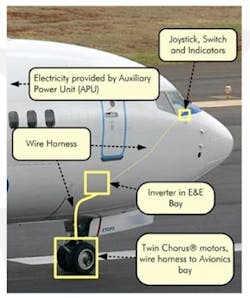New technology has continued to be developed to save fuel and cut emissions on the ramp. One program has been launched that could transform pushback and taxi operations.
WheelTug
WheelTug, an electric drive system that is incorporated into the nose wheel of an aircraft and will fly with the airplane, has been developed to taxi an aircraft from the gate to the runway without the use of aircraft engines or pushback tractors.
The WheelTug system was introduced in 2005 when a proof of concept was demonstrated on a Boeing 767. It uses electric motors that are installed in the nose wheels of the aircraft and run off the APU to generate power to taxi.
And in the program’s most recent development, it completed a test on the Boeing 737NG at Atlanta Hartsfield Jackson Airport, demonstrating that the aircraft’s APU provided sufficient power to the system while maintaining normal speed and operations.
The company has claimed the savings could be about a half a million dollars per aircraft per year. It has projected savings in the area of FOD damage, aircraft noise, ramp congestion, maintenance and fuel savings.
Though the system runs off the aircraft’s APU, WheelTug promotes less fuel usage, according to Isaiah Cox, CEO of WheelTug plc. “If they do a double-engine taxi, they are burning 25 pounds of fuel per minute and a single-engine taxi works out to about 17 pounds of fuel per minute,” he says. “WheelTug burns about 4 pounds per minute and that’s the difference.
“It’s a big difference when you’re talking about the taxi fuel margin,” he adds. “When the airplane is being fueled, the pilot always puts on too much fuel, because he never knows what kind of delay he might get in taxi. And so he has to have an extra 20- or 30-minute margin. It’s about 400 to 600 hundred extra pounds the aircraft flies with. With WheelTug, it would be about 80 to 100 pounds.”
As for the pushback operation, it would still be under the control of ground personnel to engage the system and guide the aircraft in reverse, using a joystick-controlled remote. Then the pilot would be in control for forward taxi.
Market Rollout
The system has been designed for testing on the Boeing 737NG. “Very often, the Boeing 737 business jet flies into remote air fields. They don’t know whether or not for sure the airfield is going to have a tow bar. So they carry a tow bar onboard in the cargo bay, which weighs about 1800 pounds.”
Though the system has been designed initially for the 737, it will have application for a wide range of aircraft, even some widebody aircraft, according to Cox. “But generally speaking, we see the argument that both military and narrow bodies are a better market right now,” he says.
“Initially the market is going to be retrofit for older aircraft. We see the development model quite similar to that of winglets,” he explains. “They designed winglets as a retrofit product and then once it started becoming a product reality, then the OEMs came on board to also make it part of new products.”
The company predicts it will go into production with the unit at the end of 2011. “It’s going to take 18-24 months, and we are raising funds to make that happen. We are looking for partners and investors to help make that happen.”

